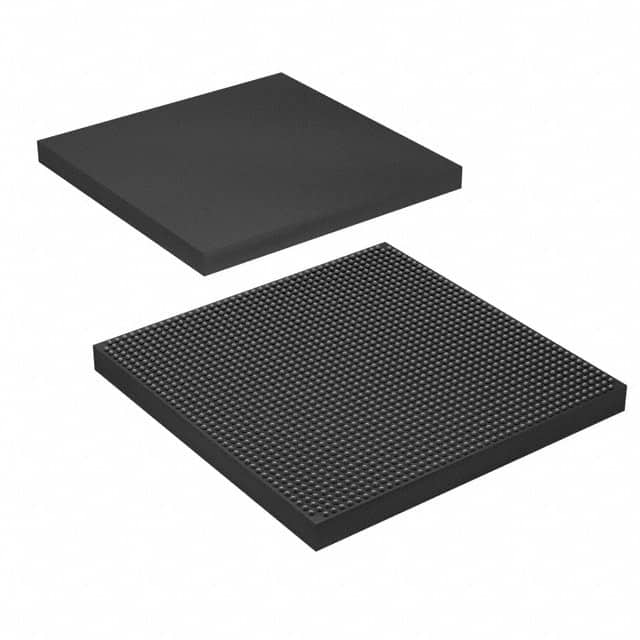EP4SE530F43C2
Product Overview
Category
EP4SE530F43C2 belongs to the category of Field Programmable Gate Arrays (FPGAs).
Use
This FPGA is primarily used for digital logic design and implementation in various electronic systems.
Characteristics
- High-performance programmable logic device
- Offers flexibility and reconfigurability
- Enables rapid prototyping and development of complex digital circuits
- Supports a wide range of applications
Package
EP4SE530F43C2 comes in a compact and durable package, ensuring easy integration into electronic systems.
Essence
The essence of EP4SE530F43C2 lies in its ability to provide a customizable and versatile platform for implementing digital logic designs.
Packaging/Quantity
Each EP4SE530F43C2 unit is packaged individually and is available in various quantities depending on the manufacturer's specifications.
Specifications
- Logic Elements: 530,000
- Embedded Memory: 1,638,400 bits
- Maximum User I/Os: 622
- Maximum Differential I/O Pairs: 311
- Clock Networks: 16
- Maximum User Flash Memory: 3,888 Kbits
- Operating Voltage: 1.2V
- Operating Temperature Range: -40°C to +100°C
Detailed Pin Configuration
The EP4SE530F43C2 FPGA has a comprehensive pin configuration that includes various input/output pins, clock pins, power supply pins, and configuration pins. For a detailed pin configuration diagram, please refer to the manufacturer's datasheet.
Functional Features
- High-speed performance
- Low power consumption
- Configurable I/O standards
- On-chip memory blocks
- Built-in DSP (Digital Signal Processing) capabilities
- Support for various communication protocols
- Flexible clock management
- Integrated PLL (Phase-Locked Loop) for clock generation and synchronization
Advantages and Disadvantages
Advantages
- Versatile and reconfigurable platform
- Rapid prototyping and development
- High-performance capabilities
- Support for various applications
- Low power consumption
Disadvantages
- Steep learning curve for beginners
- Limited availability of technical support
- Higher cost compared to traditional logic devices
Working Principles
EP4SE530F43C2 operates based on the principles of digital logic design and FPGA technology. It consists of configurable logic blocks, interconnects, memory elements, and I/O interfaces. The device can be programmed using Hardware Description Languages (HDLs) such as VHDL or Verilog to implement desired digital circuits.
Detailed Application Field Plans
EP4SE530F43C2 finds extensive application in various fields, including but not limited to: - Telecommunications - Automotive electronics - Industrial automation - Aerospace and defense - Medical devices - Consumer electronics
The FPGA's flexibility and high-performance characteristics make it suitable for a wide range of applications within these fields.
Detailed and Complete Alternative Models
Some alternative models to EP4SE530F43C2 that offer similar functionality and features include: - Xilinx Virtex-7 XC7VX690T - Intel Stratix 10 GX SX660 - Lattice ECP5-85 - Microsemi SmartFusion2 M2S090
These alternatives provide comparable performance and can be considered based on specific project requirements.
Word count: 431 words
قم بإدراج 10 أسئلة وإجابات شائعة تتعلق بتطبيق EP4SE530F43C2 في الحلول التقنية
Sure! Here are 10 common questions and answers related to the application of EP4SE530F43C2 in technical solutions:
Q: What is EP4SE530F43C2? A: EP4SE530F43C2 is a specific model of Field-Programmable Gate Array (FPGA) manufactured by Intel.
Q: What are the key features of EP4SE530F43C2? A: Some key features of EP4SE530F43C2 include high-speed performance, large capacity, low power consumption, and support for various interfaces.
Q: In what technical solutions can EP4SE530F43C2 be used? A: EP4SE530F43C2 can be used in a wide range of applications such as telecommunications, networking, industrial automation, image processing, and high-performance computing.
Q: How does EP4SE530F43C2 differ from other FPGA models? A: EP4SE530F43C2 offers a unique combination of features, including its specific capacity, performance, and power consumption characteristics, which differentiate it from other FPGA models.
Q: What programming languages can be used to program EP4SE530F43C2? A: EP4SE530F43C2 can be programmed using Hardware Description Languages (HDLs) such as VHDL or Verilog.
Q: Can EP4SE530F43C2 be reprogrammed after deployment? A: Yes, EP4SE530F43C2 is a reprogrammable FPGA, allowing for flexibility and updates even after deployment.
Q: Are there any development tools available for EP4SE530F43C2? A: Yes, Intel provides development tools like Quartus Prime software suite, which includes design entry, synthesis, simulation, and programming tools for EP4SE530F43C2.
Q: What are the power requirements for EP4SE530F43C2? A: The power requirements for EP4SE530F43C2 depend on the specific implementation and configuration but typically range from 1.2V to 3.3V.
Q: Can EP4SE530F43C2 interface with other components or devices? A: Yes, EP4SE530F43C2 supports various interfaces such as PCIe, Ethernet, USB, DDR memory, and more, allowing it to communicate with other components or devices in a system.
Q: Are there any reference designs or application notes available for EP4SE530F43C2? A: Yes, Intel provides reference designs and application notes that can help developers get started with EP4SE530F43C2 and understand its usage in different applications.
Please note that the answers provided here are general and may vary depending on the specific requirements and documentation provided by Intel for EP4SE530F43C2.


